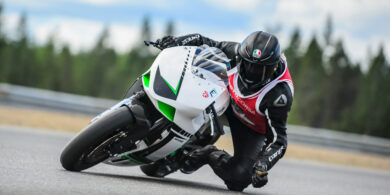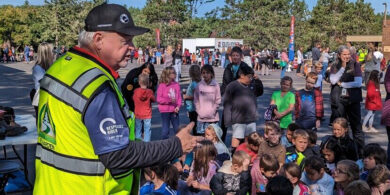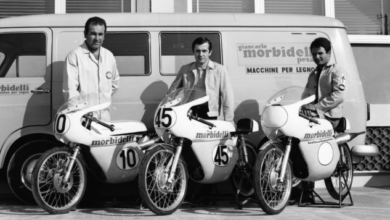April 2, 2007 – Mapping out the future of GPS
By Steve Bauer
Managing Editor
As more cars come off the assembly line with GPS systems already integrated into the dashboard, many in the powersports industry wonder if motorcycles will follow suit, especially in the touring segment.
Or will GPS units be better suited as aftermarket add-ons since many consumers want technology that can be easily transferred from vehicle to vehicle and beyond?
Considering the expanding benefits that GPS systems will provide, the question isn’t if they’ll fit into the motorcycle market, but what’s the best way to do it?
Integrated Units?
One of the questions surrounding navigational units in motorcycles is whether OEMs plan to integrate these systems into their bikes. According to Gary Gray, product manager for Victory Motorcycles, the answer largely depends on the type of bike.
“As an OEM, if you want a GPS system to be cost effective and not take away from the look of the bike, you have to integrate it into the gauge panel,” he said. “That’s something you’re already seeing on touring bikes, and for that segment I can see it becoming a standard feature in two to three years. Right now, however, it’s mostly offered as an add-on or an option.”
Gray says it’s a much more difficult task to integrate a navigational unit into a cruiser or sport bike, as riders in those market segments are mostly concerned with the look of their motorcycles. At the same time, however, he notes that riders in both segments have shown increasing interest in having a GPS unit for their bikes.
“For cruisers and sport bikes, although there is still a lot of interest, it’s much less likely to see navigation units becoming standard there. More likely they’ll become an option the manufacturer provides for the consumer,” he said. “Because again the guys who ride cruisers are concerned with comfort and style, and if you put a big LCD screen on the handlebars it will detract from that.
“Right now what most people are doing is using a hand-held device that’s bolted onto the bike. It looks kind of clunky, and although they’re not terrible, they’re not as good as they could be, and I think that’s where the future lies for these two segments, somehow integrating a hand-held unit with a factory package.”
An Aftermarket Specialty
As with most customization in the motorcycle industry, GPS aftermarket companies dominate this side of the business. One quick search on the Internet reveals dozens of companies that offer navigational units for every type of motorcycle rider. But as the old adage says, “buyer beware.” Many of these companies offer units that aren’t portable, don’t come with universal mounting brackets and sometimes aren’t even designed for motorcycles.
Ted Gartner, media relations manager for Garmin, says many buyers fall into the trap of believing that in-dash units are the wave of the future.
“In-dash navigational systems have their place, especially in automobiles. But what we’ve found in market research is that people love to have the option of portability where they can buy a unit, use it anywhere and update it as they need to,” he said. “For example, how many in-dash car phones do you see today? The answer is little to none. Back when cell phones first came on the scene, many people thought it would be a great idea to have a phone in their car. Well, of course it turned out that people wanted to be able to bring their cell phones with them everywhere, too. That same philosophy applies to GPS units, people want the portability, and in-dash units are not only more expensive, but they’re useless for most of the year if you live in a northern climate.”
Gartner points to the automotive industry to illustrate the same problems that motorcycle OEMs would have if they attempted to integrate an in-dash GPS unit into an assembly bike.
“In the automotive industry, the aftermarket navigational units far exceed anything that’s factory installed or in-dash, and the same applies to motorcycles,” he said. “First, aftermarket units are about half the price, and most important, the design time for one of our products is a year, where the design time for an OEM is three years, because they have to create a navigational system while the bike’s still in the planning stages. So what happens is by the time you purchase your new bike, you’ve got a three-year-old navigation unit in it that won’t have the features or the functions that a top-of-the-line portable would have for about half the price.”
Gartner agrees with Gray that the answer lies in combining aftermarket technology with OEM in-dash design.
“We have a bunch of different relationships with OEMs such as Harley and BMW, among others, and we’re also in talks with several more,” Gartner said. “I think the goal for everybody is to give the consumer the option to have a navigational system fit cleanly onto their bike, but at the same time give them the technology, features and portability they want.”
Gartner points to the success his company has had with its Zumo, a GPS unit designed specifically for motorcycles, but that also comes standard with a mount that riders can use for their car.
“The Zumo has a touch screen, and the buttons are designed to be big so if you’re riding with gloves you can still use it easily,” he said. “It’s got Bluetooth, so if you have a Bluetooth helmet, you don’t have to take your helmet off to pick up your phone, etc. It also has MP3 capability, instant weather reports and the ability to route you around traffic jams or construction. So although it’s designed for motorcyclists, it’s easy to see how smoothly it transitions for use in an automobile. I certainly can see aftermarket companies teaming with OEMs to create a unit that will seamlessly fit onto a bike yet be as portable as any hand-held device on the market now.”
From Gen Y to Grandpa
Both Gray and Gartner say they’re amazed when they look at who’s purchasing navigational systems for their bikes. Although the majority are younger riders who are more in tune with today’s technology, there’s a growing segment of older riders who are buying into the convenience of GPS units.
“Our customer base ranges from touring to cruisers to sport bikes, it’s across the board,” Gartner said. “We thought it was going to be more of the touring market, but in reality, it’s even more of those weekend warriors on the Harleys that do a fun run. As bike clubs get together and organize rides, with a product like the Zumo it allows you to share rides. So you can go out a month before, plan out the ride and then everybody who has a Zumo can download or get that route from you, so you know exactly which route you’ll be traveling, or you can share routes if you’ve got a particularly scenic one you want to share with your buddies.”
Although the Generation Y sector has the most interest in GPS units, according to Victory research, their knowledge of the technology is rubbing off on their parents and grandparents.
“I think with the sport bike numbers, it’s definitely a Generation Y thing, where they’re much more technically savvy, they’re waiting for the next iPod to come out so they can trade their current one in,” Gray said. “But at the same time, they’re showing the older generations how easy and convenient these units can be, and it’s starting to show in the numbers.”
Gartner agrees that many of their new customers find out about their products by word of mouth, not advertising.
“A lot of your traditional riders didn’t see the benefit right away, but as more and more GPS units get out there, it spreads the awareness among other riders about what these units can do and what’s available for their bikes,” he said. “It goes back to this sense of community, the Harley crowd in particular. It’s all about checking out each other’s bikes. If they see that one of their buddies has it and it’s working great for them and they’re using it, they’re going to want to get one, too. We target our advertising to motorcycles, but our best advertising is our customers.
“It’s fair to say that it’s more saturated in the younger market, but there are more and more older riders who are catching on to it, too. They don’t want to have to hassle with pulling over and grabbing their map every time they need to find a road, etc.”
As the technology advances on navigational units, Gartner believes more riders will see there’s much more to them than just getting directions.
“It’s going to be the traffic interfaces, the route sharing,” he said. “We’re seeing already the growth in the online community where you can get together with other motorcycle enthusiasts where you can trade rides, share them, so there’s a more community base that’s coming together. And like I said, things like traffic, weather, the cheapest gas station in the area, those are just the tip of the iceberg of things that these units will be capable of in just a few years.”




